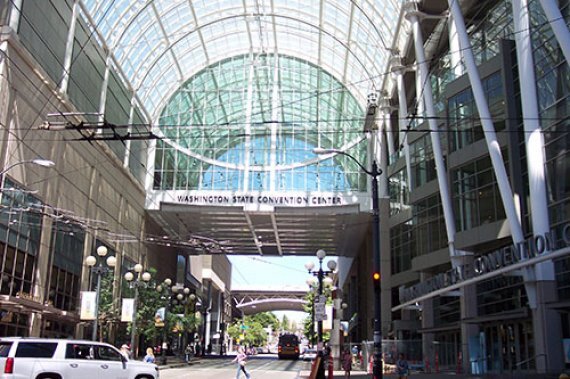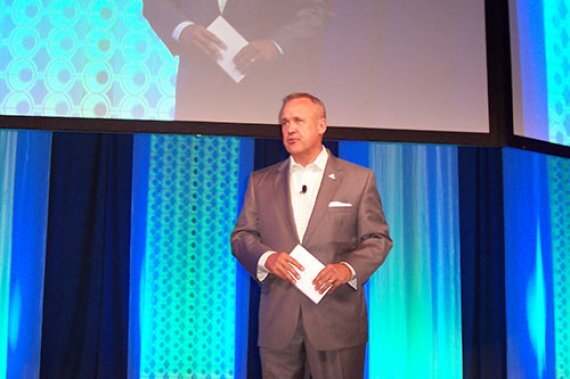

"America's credit unions know their members," said Nussle. "They see them every day. I get frustrated being lectured by policy makers or by [CFPB Director] Richard Cordray about 'consumer protection.' Credit unions have been about protecting consumers before these people were born. I'm tired of these regulations being pushed down on credit unions."
But of even greater concern to Nussle is not the ever-growing compliance burden, but the burden of relevance. "I worry how we are going to maintain our relevance into the future," he told attendees. "I worry about delivering 360-degree advocacy along with our league partners. Second is awareness. I am tired of explaining what a credit union is. Not because I am not proud, but because people should know. Third, disruption. The biggest pain point for converting someone from a bank to a credit union is filling out forms, so perhaps technology can help us. Let's actually be the disruptors in the marketplace. Either we are going to be disruptors or we are going to get disrupted. Fourth, we have to grow. Growing is winning, to me. If we can't serve generations into the future, that is not success."



To reach Millennials, Blankenship said CUs need to know what they own is less important than what they experience. "They take selfies everywhere. You will know you have reached this group when they take a selfie at your credit union. Millennials want to be part of something bigger, so make them part of something bigger." Millennials also want to save time. They love shopping via Amazon Prime and Prime Now, he continued. "Be able to visualize innovating business opportunities. 'What ifs' are a way of life at Tesla What if shopping for a car could be made fun? Almost everything we did was considered 'impossible.' To change the world, sometimes you have to do the impossible. Impossible just means it has not been done yet."
If you try to push sales on people, they become defensive, Blankenship said, but if you engage them, if you create an emotional connection, then you get them involved. "Sometimes you have to explain why you are better, as Tesla did. Tell people why your credit union is better here, here and here."
Blankenship asked CUs to ponder a scary question: What if Amazon starts offering financial services to all of its Prime members worldwide? "Somebody is going to redefine your industry sometime in the next 10 years," he warned. "There is only one question: Will it be you?"

Metsger said upon taking the reins at NCUA, he thought it was "very important" to move quickly on issues that are important to credit unions, "especially putting decisions back in your hands. We are not going to micromanage your decisions," he said to vigorous applause. "We are about to make massive changes to field of membership that will allow you to make decisions about your credit union membership on a board level."

CUs should continue to expect modest economic growth, tame inflation and labor markets near full employment, Schenk advised. He said to expect 2.25% GDP growth in 2016, followed by 2.5% in 2017. That will be lower than the 2.6% average since 1980, and lower than most recoveries. Expect 2.0% inflation in 2016 and 2.25% in 2017. "As long as inflation remains low, the Federal Reserve has wiggle room to increase short-term interest rates at a modest pace," Schenk said. "The headline numbers obscure a lot of the pain and suffering in a lot of American households."

Hampel foresees a "mixed outlook" for CU net income, but stable or rising net worth ratios. "Lower provision expenses have driven earnings over the past few years, but that is just about done," he warned.
Turning to the Temporary Corporate CU Stabilization Fund, Hampel said CUs have paid $10.4 billion of estimated $14 billion to $16 billion. The current loss estimates are down to $7.2 billion to $8.8 billion, therefore, CUs have overpaid from $1.6 billion to $3.2 billion. The good news: a refund is coming. The bad news: not until 2021. Will be a "very substantial" refund, possibly 20% of assets.

Debit interchange revenue will be "whittled away to next-to-nothing" over the next 10 years due to technology, Hampel predicted, adding this will affect all depository institutions, not just CUs. "If I was on the board of a credit union, when interest rates start rising, I would try to hold down the interest paid on a checking account."
For ROA, 80 basis points today is "the new 100," Hampel said. Because inflation is so low, a CU that grows 6% a year needs only 8% topline growth. "Capital is being less devalued by inflation," he explained.





